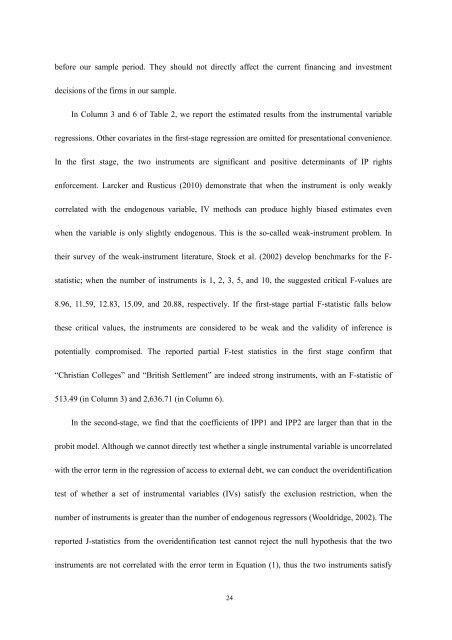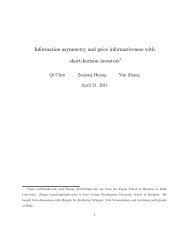Does Enforcement of Intellectual Property Rights Matter in China ...
Does Enforcement of Intellectual Property Rights Matter in China ...
Does Enforcement of Intellectual Property Rights Matter in China ...
You also want an ePaper? Increase the reach of your titles
YUMPU automatically turns print PDFs into web optimized ePapers that Google loves.
efore our sample period. They should not directly affect the current f<strong>in</strong>anc<strong>in</strong>g and <strong>in</strong>vestment<br />
decisions <strong>of</strong> the firms <strong>in</strong> our sample.<br />
In Column 3 and 6 <strong>of</strong> Table 2, we report the estimated results from the <strong>in</strong>strumental variable<br />
regressions. Other covariates <strong>in</strong> the first-stage regression are omitted for presentational convenience.<br />
In the first stage, the two <strong>in</strong>struments are significant and positive determ<strong>in</strong>ants <strong>of</strong> IP rights<br />
enforcement. Larcker and Rusticus (2010) demonstrate that when the <strong>in</strong>strument is only weakly<br />
correlated with the endogenous variable, IV methods can produce highly biased estimates even<br />
when the variable is only slightly endogenous. This is the so-called weak-<strong>in</strong>strument problem. In<br />
their survey <strong>of</strong> the weak-<strong>in</strong>strument literature, Stock et al. (2002) develop benchmarks for the F-<br />
statistic; when the number <strong>of</strong> <strong>in</strong>struments is 1, 2, 3, 5, and 10, the suggested critical F-values are<br />
8.96, 11.59, 12.83, 15.09, and 20.88, respectively. If the first-stage partial F-statistic falls below<br />
these critical values, the <strong>in</strong>struments are considered to be weak and the validity <strong>of</strong> <strong>in</strong>ference is<br />
potentially compromised. The reported partial F-test statistics <strong>in</strong> the first stage confirm that<br />
“Christian Colleges” and “British Settlement” are <strong>in</strong>deed strong <strong>in</strong>struments, with an F-statistic <strong>of</strong><br />
513.49 (<strong>in</strong> Column 3) and 2,636.71 (<strong>in</strong> Column 6).<br />
In the second-stage, we f<strong>in</strong>d that the coefficients <strong>of</strong> IPP1 and IPP2 are larger than that <strong>in</strong> the<br />
probit model. Although we cannot directly test whether a s<strong>in</strong>gle <strong>in</strong>strumental variable is uncorrelated<br />
with the error term <strong>in</strong> the regression <strong>of</strong> access to external debt, we can conduct the overidentification<br />
test <strong>of</strong> whether a set <strong>of</strong> <strong>in</strong>strumental variables (IVs) satisfy the exclusion restriction, when the<br />
number <strong>of</strong> <strong>in</strong>struments is greater than the number <strong>of</strong> endogenous regressors (Wooldridge, 2002). The<br />
reported J-statistics from the overidentification test cannot reject the null hypothesis that the two<br />
<strong>in</strong>struments are not correlated with the error term <strong>in</strong> Equation (1), thus the two <strong>in</strong>struments satisfy<br />
24



